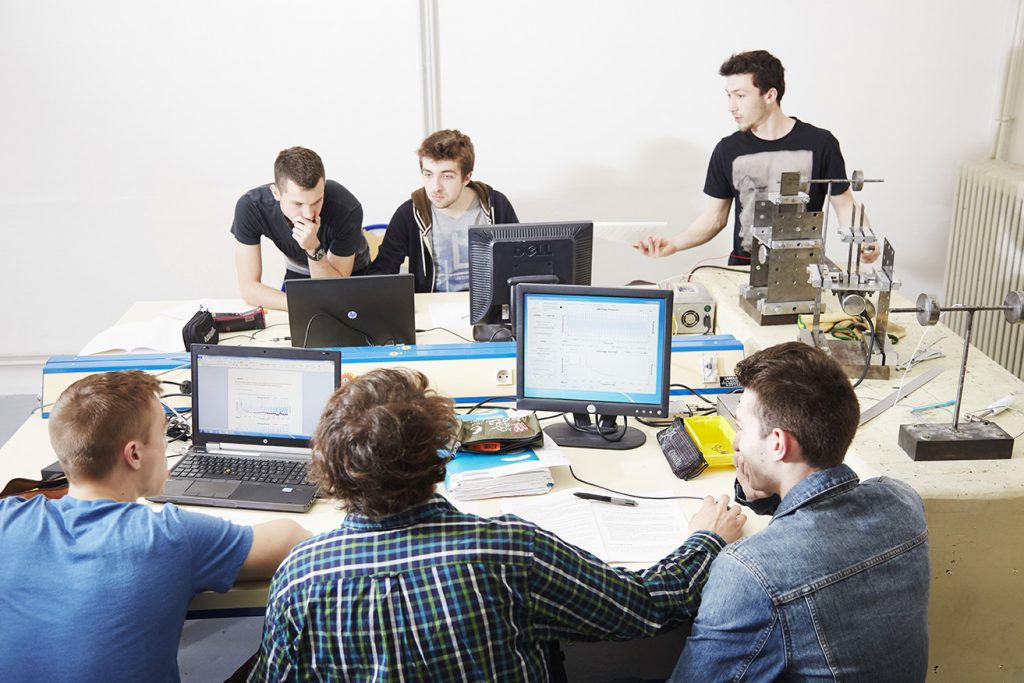Structure of the academic year
The 3rd year of the ISAE-Supméca Engineering Programme is divided in two semesters: one that is dedicated to internships and the other to studying. It also includes a Summary Project.
In third year, core teachings are supplemented with courses from a pathway system
In the 3rd year of the Engineering Programme, ISAE-Supméca offers students to focus their curriculum around a specific theme and profession by choosing a precise learning pathway. Pathways are built at the end of the 2nd year for more consistency between a student’s curriculum and their plans for the future.
3rd Year of the Engineering Programme: Core Teachings
- Systems Engineering (34 hours)
- Industrial Management Control: Business game (60 hours)
- Modern Language: English (36 hours)
Courses for semester S9
Pathway Course-Units
In 3rd year, ISAE-Supméca offers different learning pathways that enable students to broaden their engineering skills in areas that cover the entire spectrum of systems, materials and industrial systems engineering. Each of the 4 pathways represents 650 hours of training.
- Pathway 1: Materials, Processes and Simulation
Choosing materials consistently with provided functional specifications by taking their manufacturing method and the socio-economic environment into account. Technological, physical and digital aspects of materials as their properties, behaviours, manufacturing processes, and their integration into the production unit.
Prospects: Design, research & development, methods, product and component manufacturing.
Areas: aeronautics, energy, transportation, research and consultancy.
Courses for pathway MPS
- Pathway 2: Mechanical Design & Simulation
Design, model, simulate and optimise a mechanical system interacting with its environment, as well as carrying out experimental methods to validate this overall approach. The themes studied in this pathway are broad and they cover the dimensioning of components, structural dynamics, wave propagation, digital simulation and modelling and more. They address the current issues encountered in these disciplines such as the reduction of noise and vibrations, non-linear structure behaviours, the downsizing of digital models, and taking composite, smart or functionalised materials into account.
Prospects: research & development or design office position
Areas: aeronautics, automobile, railway, energy, space…
Courses for pathway SCM
- Pathway 3: Mechatronics, Complex Systems
With a view to achieving optimal and agile designs, mechatronic and complex systems will be studied and designed following a systems engineering approach. Their validation, inspection and dependability will be achieved through multiphysical optimisation, in a context of knowledge acquisition and reuse performed in collaborative engineering, in order to guarantee their sturdiness. Practical application will cover CAN automobile networks, automated and robotised systems (telescope, Segway, etc.), electromechanical actuators in aeronautics, 3D printing of mechatronised and connected components, as well as cyber-physical production systems.
Prospects: Any area requiring mechatronic-related skills, ranging from cosmetics to space engineering, including positions in research & development and design offices.
Courses for pathway MSC
- Pathway 4: Production Systems and Logistics
To design, organise, drive and optimise a production system and its logistics. Case studies, role-play simulations and business games will be used to cover the main concepts, methods, tools and techniques that are involved in the logistics chain: operational research, optimisation, planning, information systems (SAP specifically), strategic purchases, lean manufacturing and lean development, quality, Six Sigma, management of advanced projects.
Prospects: Engineers who have chosen this pathway will be able to take on responsibilities in a business environment in compliance with the principles of sustainability, and by using their skills to ensure the highest level of performance, quality and safety. Their expertise will be applied to the facilities, products, relationships and information at stake, and to a company’s organisation and environment.
Courses for pathway SPL
The Summary Project
The Summary Project is carried out before students begin their Engineering Internship. It is aimed at the practical application of the knowledge and expertise students have acquired in the pathway courses.
The Engineering Internship: the first step to becoming an engineer
The Engineering Internship is at least 6 months in duration and is a genuine period of professional integration for students. In an industrial environment, engineering students put the knowledge they have acquired during their three-year curriculum into practice. It enables students to be as operational as possible.











